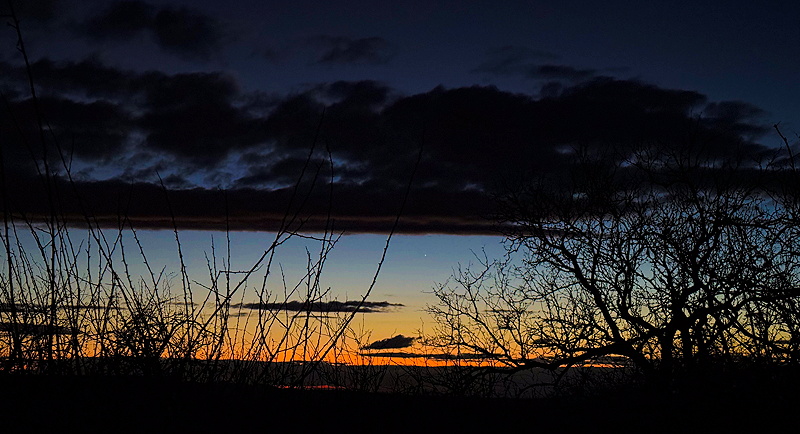iPhone Mercury, Comet Pons-Brooks, Moon
Posted: 17 March 2024
Nineteen years ago on 12 March 2005, I visited what I then called Oracle Observatory for the first time! Unfortunately, the sky was cloudy on 12 March 2024. With rain in the forecasts, Thursday morning, 14 March, I put the Dome Cover ON. Rain (0.57") and even several periods of graupel arrived Friday afternoon, 15 March. I have been hoping to do a dry run for the 8 April Total Solar Eclipse since the beginning of March, but cloudy days and/or strong winds have kept me from doing it. As sunset approached on Saturday, 16 March, the sky began some clearing. I decided to open the observatory to check out Comet 12P/Pons-Brooks.
|
Open: Saturday, 16 March 2024, 1759 MST Temperature: 65°F |
Session: 1949 Conditions: Mostly clear |
Equipment:
12" f/8 LX600 w/StarLock
2" 24mm UWA eyepiece
2" 30mm UWA eyepiece
12x50 binoculars
Camera:
iPhone 15 Pro Max
Dome Cover OFF.
1816 MST: LX600 ON, StarLock OFF, High Precision OFF.
1819 MST: Viewed Jupiter, 102X. No moons visible in the bright sky.
1827 MST: Viewed Mercury, low in the western sky, 102X.
1834 MST: Sunset. Time approximate due to clouds along the western horizon.
1838 MST: Viewed Jupiter, 102X. Three moons visible in the bright twilight sky.
1849 MST: Viewed Jupiter, 102X. All four Galilean Moons were now visible.
Clouds increasing from the south.
1859 MST: Wi-Fi ON.
Used SkySafari 7 Pro on the iPhone 15 Pro Max to GOTO Comet 12P/Pons-Brooks. It was not yet visible in the bright twilight sky. The race was now on: would the comet become visible before clouds obscured it. The clouds were now at the Zenith by the Moon.
1913 MST: iPhone 15 Pro Max photo of clouds along the western horizon with Mercury near the center.

1916 MST: Viewed Comet 12P/Pons-Brooks, 81X.
1917 MST: Wi-Fi OFF.
Attached the LiDAR Cover on the iPhone and mounted the iPhone on the 2" 30mm eyepiece using the Accuview 3-Axis Smartphone Adapter.
1920 MST: StarLock ON.
1924 MST: iPhone afocal 81X image of Comet 12P/Pons-Brooks, StarLock autoguided, NightCap Camera (Long Exposure, Light Boost, ISO 10000, 1sec, 1 minute, 1X lens).

1927 MST: StarLock OFF.
1929 MST: Viewed Comet 12P/Pons-Brooks, 12x50 binoculars. It was briefly visible just before clouds covered it.
1935 MST: Viewed the Moon, 81X.
1937 MST: Mounted the iPhone for this afocal 81X image of the Moon taken with NightCap Camera (ISO 55, 1/1800sec, 1X lens).

With clouds now in much of the sky, I took a final look at the Moon, 102X.
1942 MST: LX600 OFF.
|
Close: Saturday, 16 March 2024, 1950 MST Temperature: 48°F |
Session Length: 1h 51m Conditions: Mostly cloudy |
Check this out: Museum eclipse event highlighting Seymour natives.
Comments are welcome using Email. Please read the Email Etiquette guidance.
Cassiopeia Observatory Home Page
Copyright ©2024 Michael L. Weasner / mweasner@mac.com.
URL = http://www.weasner.com/co/Reports/2024/03/17/index.html
